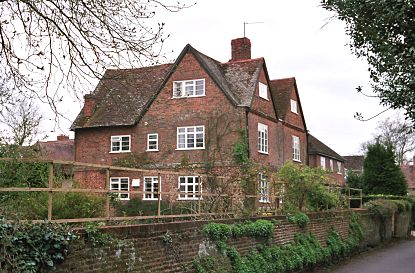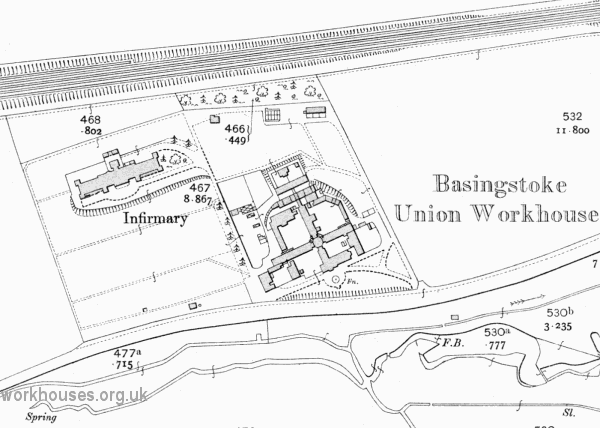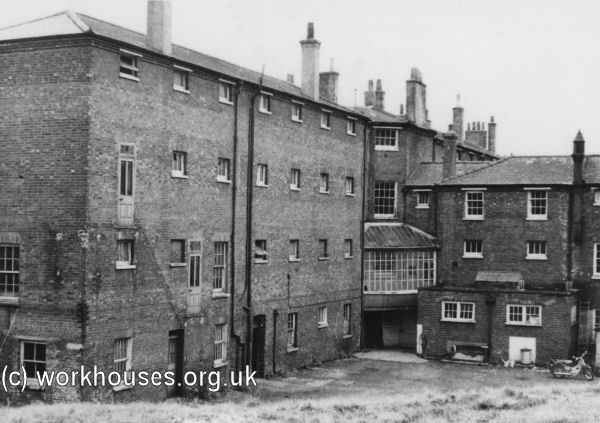Basingstoke, Hampshire
Up to 1834
A parliamentary report of 1777 recorded parish workhouses in operation in Basingstoke (for up to 56 inmates) and Basing (30 inmates).
Basing's parish workhouse was located on Church Lane, Old Basing, in what is now Church Lane House.

Basing former parish workhouse, 2004.
© Peter Higginbotham.
After 1834
Basingstoke Poor Law Union was formed on 18th May 1835. Its operation was overseen by an elected Board of Guardians, 41 in number, representing its 37 constituent parishes as listed below (figures in brackets indicate numbers of Guardians if more than one):
Hampshire:
Basing (2), Basingstoke (4), Bradley, Bramley, Cliddesden, Dean [Deane], Dummer, Eastrope [Eastrop], Ellisfield, Farleigh Wallop, Hartley Wespall, Herriard, Mapledurwell, Monk Sherborne, Nateley Skewers [Scures], Newnham, Nutley, Oakley, Pamber, Popham, Preston Candover, Sherborne St John, Shirfield [Sherfield-on-Loddon], Silchester, Steventon, Stratfield Saye, Stratfield Turgis, Tunworth, Up Nateley, Upton Grey, North Waltham, West Sherborne, Weston Patrick, Winslade and Kempshot, Woodmancot [Woodmancott], Wootton St Lawrence, Worting.
Berkshire: Beech Hill.
Later Additions: Andwell, Mortimer West End (from 1866).
The population falling within the union at the 1831 census had been 15,479 with parishes ranging in size from from Eastrop (population 69) to Basingstoke itself (3,581). The average annual poor-rate expenditure for the period 1832-35 had been £13,324 or 17s.3d. per head of the population.
The Basingstoke Union workhouse was built in 1835-6 at a site to the east of the Basingstoke on the north side of the Basing Road. The architect was Sampson Kempthorne who was the architect of many early Union workhouses including those for the Andover, Droxford, New Forest and Winchester Unions. Basingstoke workhouse was broadly based on his model "square" plan which had a front administrative block, behind which four accommodation wings radiated from a central supervisory hub. The areas between the wings formed segregated exercise yards for the different classes of inmate (old/young, male/female etc.) In 1836, the Poor Law Commissioners authorized the sum of £7,500 for the construction of a building to accommodate 400 inmates. The workhouse location and layout are shown on the 1910 map below.

Basingstoke workhouse site, 1910.

Basingstoke workhouse from the north-east, date unknown.
© Peter Higginbotham.
On 3 May 1900, the Chairman of the Guardians, Mr F.M.E. Jervoise opened a new infirmary located at the north-west of the workhouse. The building was the subject of a local press report:
...
[Mr Jervoise said that the] first proposal in 1895 was to build a hospital with 40 beds, and a resolution to that effect was passed. That proposal was not carried out, in the first place because it would only have accommodated half their sick, and in the second they had not good site to build upon. No-one was more anxious than he was that proper accommodation should be provided for the sick, but he could not concur in building an Infirmary that knew must be added to in a few years. In January, 1897, they were fortunate enough to be able to purchase, by the consideration of Lord Bolton, about five acres of land adjoining the Workhouse grounds This land they had rented for some years, but until they had bought the freehold they could not use it for building. Having acquired the requisite ground on the 8th May, a resolution was passed by the Guardians to build a new Infirmary not restricted in accommodation, and a Committee was deputed to settle the number of beds and to bring up plans. In consultation with the Inspector and architect the Local Government Board plans were prepared which were approved by the Board, and the first stone was laid on the 27th May. 1898. Now the Infirmary had been completed they hoped soon to move their sick from the present quarters to that new building. They had not only an excellent Hospital, fitted with everything that was necessary, but one that would hold their sick for many years, and also provide good accommodation for their nursing staff. The Guardians recognised that Basingstoke and the district were increasing in population, and had looked ahead so as not to have add to the building in a few years. With regard the cost, the building could not be said to be expensive when they considered the accommodation provided. There were four large wards, which would hold from 16 to 18 beds, eight small wards, which would take about 20 beds and lying-in wards, making altogether accommodation for about 100 beds, besides nurses' bed and sitting-rooms. The expenditure the building, including gas and water laid on, sewage disposal, and furniture, was just about £10,000.
From 1930, the workhouse was redesignated as a Public Assistance Institution. From 1948 it became Basing Road Hospital and the old buildings replaced. The site was sold off in 1983.
Staff
Inmates
Records
Note: many repositories impose a closure period of up to 100 years for records identifying individuals. Before travelling a long distance, always check that the records you want to consult will be available.
- Hampshire Record Office, Sussex Street, Winchester SO23 8TH. Very few records survive — holdings include Guardians' minute books (1835-1930); Committee minutes (1910-36); Ledger (1923-30); etc.
Bibliography
- Large, Barbara (2016) Basingstoke Workhouse and Poor Law Union
Links
- None.
Unless otherwise indicated, this page () is copyright Peter Higginbotham. Contents may not be reproduced without permission.


